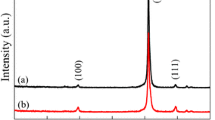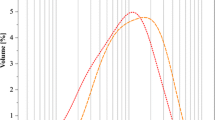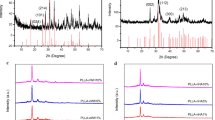Abstract
In vitro degradation properties and cytocompatibility of surface-grafted magnesia whiskers/poly(l-lactide) (g-MgO–Ws/PLLA) composite films which obtained by solution casting method were studied in this work. In vitro degradation experiments of the samples were carried out in a PBS solution at 37 °C with a pH of 7.4. Changes in weight, pH value, crystallization and melting behaviors, surface morphology and chemical composition, and tensile property of the g-MgO–Ws/PLLA composite films with the degradation time were characterized, from which the related degradation mechanism of the composite was concluded. Results showed that the weight loss of the g-MgO–Ws/PLLA composite films was slightly higher than that of the neat PLLA. The alkaline g-MgO–Ws can neutralize the acidity of degradation products of PLLA to some extent and maintain the tensile properties of the films well in the early degradation stage compared with neat PLLA. With the degradation, the crystallinity of PLLA matrix increased first and then decreased. In vitro cell culture results, based on the optical density value, alkaline phosphate (ALP) activity measurement, field emission scanning electron microscope, and confocal laser scanning microscopy observation, revealed that the g-MgO–Ws/PLLA composite films were not only in favor of cells adhesion, spreading, and proliferation, but also can significantly upregulate the ALP activity and promote the osteogenic differentiation of MC3T3-E1 cells compared with the neat PLLA film.













Similar content being viewed by others
References
Hutmacher DW (2000) Scaffolds in tissue engineering bone and cartilage. Biomaterials 21:2529–2543
Moravej M, Mantovani D (2011) Biodegradable metals for cardiovascular stent application: interests and new opportunities. Int J Mol Sci 12:4250–4270
Langer R, Vacanti JP (1993) Tissue engineering. Science 260:920–926
Rezwan K, Chen QZ, Blaker JJ, Boccaccini AR (2006) Biodegradable and bioactive porous polymer/inorganic composite scaffolds for bone tissue engineering. Biomaterials 27:3413–3431
Park JE, Todo M (2011) Development and characterization of reinforced poly (l-lactide) scaffolds for bone tissue engineering. J Mater Sci Mater Med 22:1171–1182
Jiang XL, Zhang TZ, He SY, Ling JJ, Gu N, Zhang Y, Zhou XF, Wang X, Cheng L (2012) Bacterial adhesion on honeycomb-structured poly (l-lactic acid) surface with Ag nanoparticles. J Biomed Nanotechnol 8:791–799
Liu PF, Yu H, Sun Y, Zhu MJ, Duan YR (2011) A mPEG-PLGA-b-PLLA copolymer carrier for adriamycin and siRNA delivery. Biomaterials 33:4403–4412
Nampoothiri KM, Nair NR, John RP (2010) An overview of the recent developments in polylactide (PLA) research. Bioresour Technol 101:8493–8501
Li X, Chu CL, Liu L, Liu XK, Bai J, Guo C, Xue F, Lin PH, Chu PK (2015) Biodegradable poly-lactic acid based-composite reinforced unidirectionally with high-strength magnesium alloy wires. Biomaterials 49:135–144
Yuan YS, Wong MS, Wang SS (1996) Mechanical behavior of MgO-whisker reinforced (Bi, Pb)2Sr2Ca2Cu3Oy high-temperature superconducting composite. J Mater Res 11:1645–1652
Li YH, Sun XS (2010) Preparation and characterization of polymer-inorganic nanocomposites by in situ melt polycondensation of l-lactic acid and surface-hydroxylated MgO. Biomacromolecules 11:1847–1855
Ma FQ, Lu LX, Wang ZM, Sun ZJ, Zhang FF, Zheng YF (2011) Nanocomposites of poly(l-lactide) and surface modified magnesia nanoparticles: fabrication, mechanical property and biodegradability. J Phys Chem Solids 72:111–116
Zreiqat H, Howlett CR, Zannettino A, Evans P, Tanzil GS, Knabe C, Shakibaei M (2002) Mechanisms of magnesium-stimulated adhesion of osteoblastic cells to commonly used orthopaedic implant. J Biomed Mater Res 62:175–184
Witte F (2010) The history of biodegradable magnesium implants: a review. Acta Biomater 6:1680–1692
Staiger MP, Pietak AM, Huadmai J, Dias G (2006) Magnesium and its alloys as orthopedic biomaterials: a review. Biomaterials 27:1728–1734
Wen W, Luo BH, Qin XP, Li CR, Liu MX, Ding S, Zhou CR (2015) Strengthening and toughening of poly(l-lactide) composites by surface modified MgO whiskers. Appl Surf Sci 332:215–223
Kokubo T, Takadama H (2006) How useful is SBF in predicting in vivo bone bioactivity? Biomaterials 27:2907–2915
Wu L, Ding J (2004) In vitro degradation of three-dimensional porous poly (d, l-lactide-co-glycolide) scaffolds for tissue engineering. Biomaterials 25:5821–5830
Zhang K, Wang YB, Hillmyer MA, Francis LF (2004) Processing and properties of porous poly (l-lactide)/bioactive glass composites. Biomaterials 25:2489–2500
Chen HM, Feng CX, Zhang WB, Yang JH, Huang T, Zhang N, Wang Y (2013) Hydrolytic degradation behavior of poly(l-lactide)/carbon nanotubes nanocomposites. Polym Degrad Stab 98:198–208
Frone AN, Berlioz S, Chailan JF, Panaitescu DM (2013) Morphology and thermal properties of PLA–cellulose nanofibers composites. Carbohydr Polym 91:377–384
Mikos AG, Thorsen AJ, Czerwonka LA, Bao Y, Langer R, Winslow DN, Vacanti JP (1994) Preparation and characterization of poly(l-lactic acid) foams. Polymer 35:1068–1077
Larrañaga A, Aldazabal P, Martin FJ, Sarasua JR (2014) Hydrolytic degradation and bioactivity of lactide and caprolactone based sponge-like scaffolds loaded with bioactive glass particles. Polym Degrad Stab 110:121–128
Wu YH, Li N, Cheng Y, Zheng YF, Han Y (2013) In vitro study on biodegradable AZ31 magnesium alloy fibers reinforced PLGA composite. J Mater Sci Technol 29:545–550
Joaquin RR, Vidaurre A, Isabel CC, Lebourg M (2015) Effects of hydroxyapatite filler on long-term hydrolytic degradation of PLLA/PCL porous scaffolds. Polym Degrad Stab 119:121–131
Mitsuhiro S, Yusuke I, Masanao M (2006) Mechanical properties, morphology, and crystallization behavior of blends of poly(l-lactide) with poly(butylene succinate-co-l-lactate) and poly(butylene succinate). Polymer 10:3557–3564
Zou ZP, Luo C, Luo BH (2016) Synergistic reinforcing and toughening of poly(l-lactide) composites with surface-modified MgO and chitin whiskers. Compos Sci Technol 133:128–135
Loo JSC, Ooi CP, Boey FYC (2005) Degradation of poly (lactide-co-glycolide) (PLGA) and poly(l-lactide) (PLLA) by electron beam radiation. Biomaterials 26:1359–1367
Lorenzo MLD (2005) Crystallization behavior of poly (l-lactic acid). Eur Polym J 41:569–575
He Y, Fan Z, Wei J, Li S (2006) Morphology and melt crystallization of poly(l-lactide) obtained by ring opening polymerization of l-lactide with zinc catalyst. Polym Eng Sci 46:1583–1589
Sim KJ, Han SO (2010) Dynamic mechanical and thermal properties of red algae fiber reinforced poly(lactic acid) biocomposites. Macromol Res 18:489–495
Suksut B, Deeprasertkul C (2011) Effect of nucleating agents on physical properties of poly(lactic acid) and its blend with natural rubber. J Polym Environ 19:288–296
Verrier S, Blaker JJ, Maquet V, Hench LL, Boccaccini AR (2004) PDLLA/bioglass composites for soft-tissue and hard-tissue engineering: an in vitro cell biology assessment. Biomaterials 25:3013–3021
Burridge K, Fath K (1989) Focal contacts: transmembrane links between the extracellular matrix and the cytoskeleton. BioEssays 10:104–108
Anselme K (2000) Osteoblast adhesion on biomaterials. Biomaterials 21:667–681
Hott M, Noel B, Bernache-Assolant D, Rey C, Marie PJ (1997) Proliferation and differentiation of human trabecular osteoblastic cells on hydroxyapatite. J Biomed Mater Res 37:508–516
Li N, Chen G, Liu J, Xia Y, Chen HB, Tang H, Zhang FM, Gu N (2014) Effect of surface topography and bioactive properties on early adhesion and growth behavior of mouse preosteoblast MC3T3-E1 cells. Appl Mater Interfaces 6:17134–17143
Wei B, Shang YX, Li M, Jiang J, Zhang H (2014) Cytoskeleton changes of airway smooth muscle cells in juvenile rats with airway remodeling in asthma and the RhoA/ROCK signaling pathway mechanism. Genet Mol Res 13:559–569
Tao CT (2006) Polyetherimide membrane formation by the cononsolvent system and its biocompatibility of MG63 cell line. J Membr Sci 269:66–74
Busa WB, Nuccitelli R (1984) Metabolic regulation via intracellular pH. Am J Physiol Regul Integr Comp Physiol 246:409–438
Acknowledgements
This work was supported by the National Natural Science Foundation of China (31570981, 31571030, and 51473069), Project on the Integration of Industry, Education and Research of Guangdong Province (2013B090500107), Guangdong Provincial Natural Science Foundation of China (2016A030313086), and Science and Technology Program of Guangzhou, China (No. 201510010135).
Author information
Authors and Affiliations
Corresponding authors
Rights and permissions
About this article
Cite this article
Wen, W., Zou, Z., Luo, B. et al. In vitro degradation and cytocompatibility of g-MgO whiskers/PLLA composites. J Mater Sci 52, 2329–2344 (2017). https://doi.org/10.1007/s10853-016-0525-0
Received:
Accepted:
Published:
Issue Date:
DOI: https://doi.org/10.1007/s10853-016-0525-0




